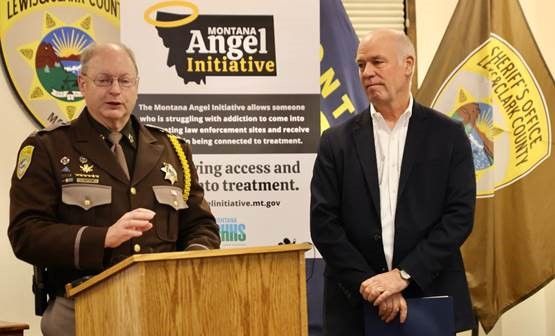FOR IMMEDIATE RELEASE
Date: February 01 2022
Contacts:
Brooke Stroyke, Office of the Governor
Jon Ebelt, Department of Public Health and Human Services
Gov. Gianforte, DPHHS Partner With Lewis and Clark County Sheriff on Angel Initiative
New partnership program aims to increase access to treatment
HELENA, Mont. – Today with Montana Department of Public Health and Human Services (DPHHS) Director Adam Meier, Lewis and Clark County Sheriff Leo Dutton, and Todd Wilson of the Helena Indian Alliance, Governor Greg Gianforte emphasized the state’s commitment to combating addiction and increasing access to treatment through the state’s new Angel Initiative.
“Addressing the substance use crisis in Montana requires creative solutions and thinking outside of the box. That’s what we’re doing with the Angel Initiative,” Governor Gianforte said. “By partnering with sheriffs and treatment providers across the state, we aim to reduce the stigma associated with treatment and guide more individuals on the path to recovery.”
 Gov. Gianforte and Sheriff Dutton promoting the Angel Initiative
Gov. Gianforte and Sheriff Dutton promoting the Angel Initiative
A collaborative effort among Gov. Gianforte, DPHHS, participating local law enforcement agencies, and treatment providers, the Angel Initiative allows an individual struggling with addiction and substance use to go into any participating law enforcement office and receive assistance to get connected with treatment.
To date, 20 Montana sheriffs have committed to join the effort. After receiving training from the state, sheriffs in Cascade County and Lewis and Clark County are considered in active status. The online state map indicates counties that have received training and are considered active as well as those that will be active once officials receive training.
“As we continue to expand the new initiative in Montana, we’re thankful for the partnership with Lewis and Clark County,” Meier said. “Montana continues to experience spikes in drug overdoses statewide, and we cannot continue down the current path. Access to treatment is key, and by working together I’m confident we can make a difference in Montana and save lives in the process.”
At an event today at the Lewis and Clark County Sheriff’s Office, Sheriff Leo Dutton emphasized the harsh reality substance use has in the county. “I see on a daily basis the impact substance use is having in our communities, and we just have to redouble our efforts to improve access to treatment,” he said.
A toll-free number connects law enforcement to the Angel Line where a mental health professional will assess the level of care an individual may need. If there is no availability in the local community, the Angel Line will provide alternate options for treatment in nearby communities. A placement for treatment is not guaranteed, and the participant may be placed on a wait list.
DPHHS has worked with the Behavioral Health Alliance of Montana to enroll substance use treatment providers. Todd Wilson of the Helena Indian Alliance, who joined the governor, director, and sheriff at today’s event, is one of 10 participating providers that collectively serve 33 counties.
“This program is an excellent tool that can help connect people with the treatment they need,” Wilson said. “We are eager to work with Sheriff Dutton and others to move this initiative forward. It takes all of us working together, and we’re excited to do our part to make this program a success.”
Meier said similar programs have been successful in other states, citing the Kentucky State Police starting a similar initiative in 2016 with all 16 Kentucky State Police Posts participating. The Kentucky program has helped place several hundred individuals seeking treatment.
Information about the new program is available at angelinitiative.mt.gov. The website features a map of participating locations, including specific contact information for each location.
DPHHS cites several key statistics describing the impact of substance use in Montana:
- DPHHS estimates that approximately 90,000 Montanans have a substance use disorder, but realistically only a fraction of these people seek treatment in any given year.
- EMS agencies are being called to more opioid-related events than ever before. From January through September 2021, the state averaged 69 opioid overdose calls per month. And, from late spring through summer 2021, Montana saw some of the highest opioid overdose monthly call volumes in the last three years, with a peak of 86 calls in July.
- In 2019, the annual methamphetamine-related death rate in Montana was 7.2 per 100,000 people, exceeding the national average of 5.7 per 100,000 people.

